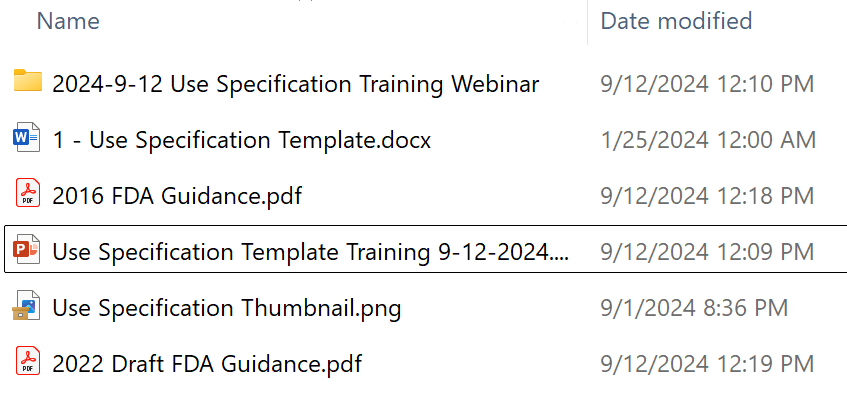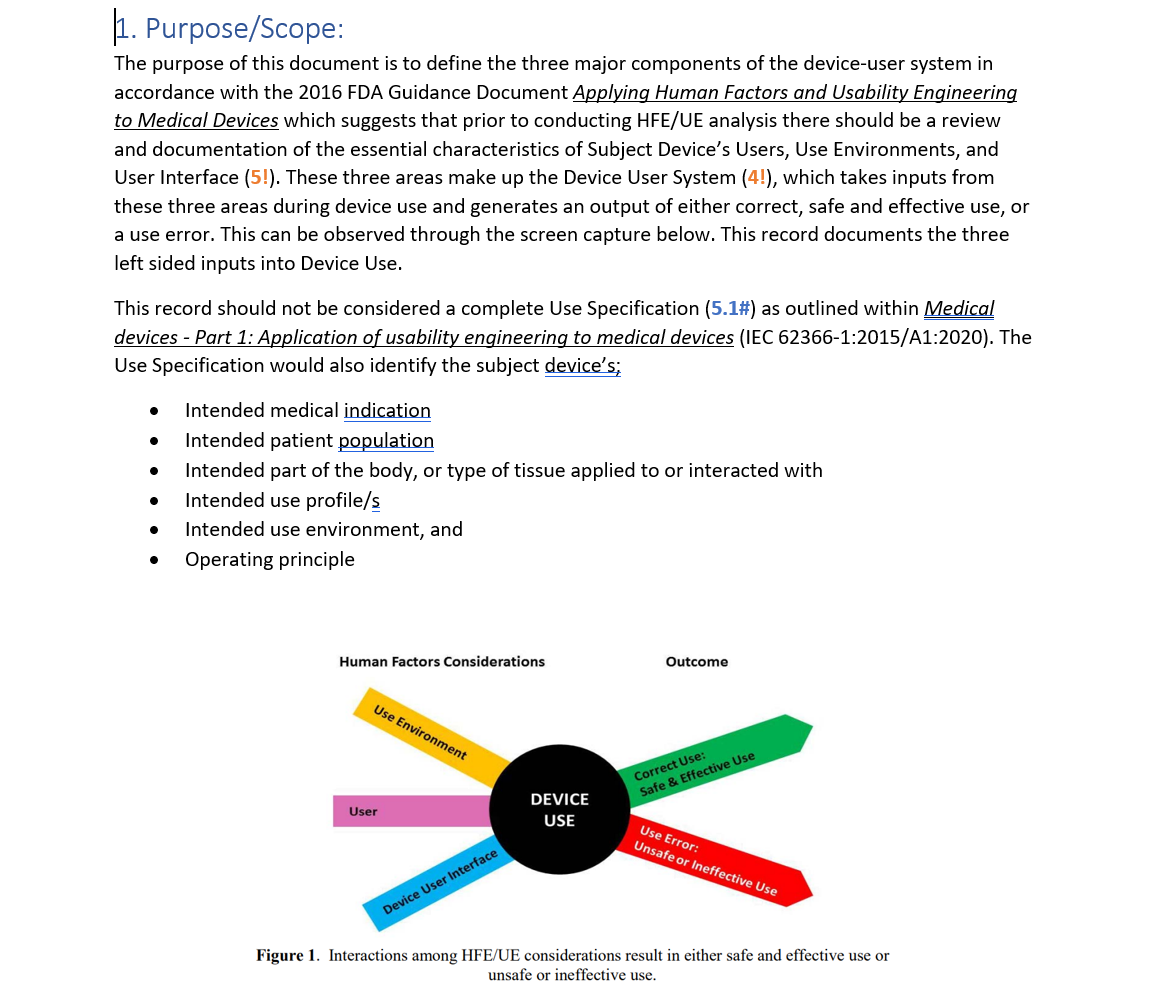This webinar will explain how to properly complete a use specification as the first step in building your usability engineering file.
Use Specification Template & Webinar Bundle ($79)
Please note: This product will be delivered to the email address provided in the shopping cart transaction. After verifying the transaction, please check your email for the download (including your spam folder).
When is the Use Specification Webinar?
This webinar was hosted live on Thursday, September 12, 2024 @ 10:30 a.m. ET. If you were unavailable for the live presentation, the session was recorded. You can download the recording and watch the training as often as you wish.
What you will receive
- Use Specification Template
- Access to download the recording of the webinar from our Dropbox folder
- Native slide deck for this webinar
- FDA Guidance on Human Factors

There are 34 slides in the presentation, and the presentation was 51 minutes in duration. All content deliveries will be sent via AWeber emails to confirmed subscribers.
What is the difference between the IEC 62366-1 and FDA requirements?
The FDA requirements for a description of the device-user system is a sub-set of the requirements for a use specification as defined in IEC 62366-1, Clause 5.1. Therefore, if you create a use specification that complies with IEC 62366-1, then this document can be submitted to the FDA instead of creating a separate description of the device-user system. The only unique element of use specification requirement is the “operating principle.” There are other minor differences between the two documentation requirements, but those differences are specific to the IEC 62366-1 definition of individual elements in the use specification (which will be described in detail during the training webinar).
Why do regulators need a use specification?
To properly assess use-related risks for devices, you first need to understand the intended users, the intended patient population, the use environment, and the device-user interfaces. Ideally, all of this information is included in your Instructions for Use (IFU) and your device description. IEC 62366-1, Clause 5.1, requires that manufacturers create a use specification as the first required elements of your usability engineering file (UEF).
Our General Approach
You should start your human factors process by defining the intended user of your device and by defining if there is more than one user group. In our device description template we have subsections that identify the intended users, the intended patient population, and the environment of use. Each of these sections is near the beginning of our device description template, immediately after the indications for use. Later in the device description template, the are subsections looking for pictures of the functional elements of your device. These pictures should include any elements that are part of the device-user interface. If you properly fill in the device description template with these details, creating a use specification is trivial, because you only need to copy and paste the information from your device description into the use specification. The only remaining element of a use specification that is not found in a description of the device-user system is the “operating principle.” Our device description includes a section titled “principles of operation” that can be copied to meet this required.
What will happen if you forget to include this information in your submission?
If you forget to include a use specification in your usability engineering file (UEF), this will be identified as a deficiency by certification bodies and electrical safety testing labs. In addition, the FDA requires a description of your device-user system in your 510(k) submission, and you will receive a deficiency if this is not identified. In fact, reviewers may refuse to review the rest of the human factors documentation if this basic information is omitted from a pre-sub questions about human factors or your pre-market submission.
Other Usability Engineering / Human Factors Training
- Human Factors Training Series – $950
- Formative Usability Testing Webinar & Template Bundle – $79
- Use Error and Abnormal Use Decision Tree Training – $79
- Known Use Errors Search Webinar – $129
- Task Analysis Template & Webinar Bundle – $129
- Use-Related Risk Analysis (URRA) Template & Webinar Bundle – $299
- Participant Screening & Data Collection Forms – $79
- Summative Usability Testing Protocol & Webinar Bundle – $199
- Summative Usability Testing Report – Live-streaming Free Webinar
About Your Instructor
Rob Packard is a regulatory consultant with ~25 years of experience in the medical device, pharmaceutical, and biotechnology industries. He is a graduate of UConn in Chemical Engineering. Rob was a senior manager at several medical device companies—including the President/CEO of a laparoscopic imaging company. His Quality Management System expertise covers all aspects of developing, training, implementing, and maintaining ISO 13485 and ISO 14971 certifications. From 2009 to 2012, he was a lead auditor and instructor for one of the largest Notified Bodies. Rob’s specialty is regulatory submissions for high-risk medical devices, such as implants and drug/device combination products for CE marking applications, Canadian medical device applications, and 510(k) submissions. The most favorite part of his job is training others. He can be reached via phone at 802.281.4381 or by email. You can also follow him on YouTube, LinkedIn, or Twitter.


